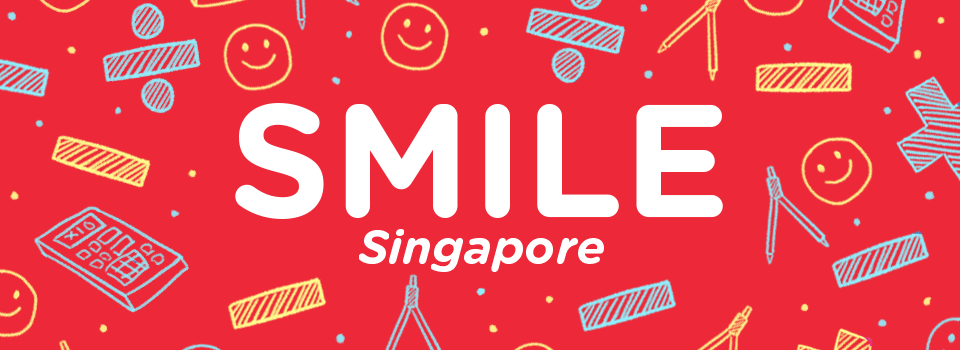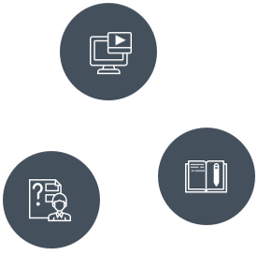
Adding Fun to the FUNdamentals
of Learning Math!
SMILE Singapore is designed with a purposeful flow, sequence and structure of learning, to build strong foundations and proficiency. Aligned to Singapore MOE Maths curriculum.
8 levels of learning programmes, catered to your child’s learning needs. Check out the full topics covered in each level below.
Our Maths Programme Video
Power-packed programmes
Model for Success
Uses world renowned Singapore Maths methods
Future Ready
Animation activates important 21st century skills like Critical Thinking, Creativity, Communication & Collaboration.
Fun & Exciting
Digitally animated lessons to Boost concept understanding & application
Comprehensive
Close to 100 lesson videos per grade
Effective
Online quizzes and downloadable worksheets to reinforce knowledge
Trusted
Developed by professionally trained & experienced teachers and tutors
Global Coverage
4 programmes aligned to various Maths curriculums
Syllabus Available
Start here for a strong base – kick start your child’s knowledge base, with innovative Singapore Math models. Learn to add and subtract using techniques like Making Tens and using Number Bonds, and more. Learn through stories on the order of numbers and their place values. Learn concepts of time, money and length through simple yet effective animation.
VIEW TOPICS
Place Values, Counting in Groups of Ten, Number Patterns, Addition, Subtraction, Multiplication and Division, Grouping, Ordinal numbers, Comparison “More, Less, Fewer”.
Money
Counting in Cents up to $1 and Dollars up to $100.
Shapes
2-D Shapes
Statistics
Reading data from Picture Graphs
Time
Telling time to the Hour and Half Hour
Length
Learning measurement with objects
Primary 2
Build on the foundations of Primary One through more stories and journeys with our animated friends. Learn about Numbers and their operations especially multiplication and division. Get an early introduction to the idea of fractions. Learn how to tell the time.
VIEW TOPICS
Whole Numbers
Place values, Compare and Order in Number Patterns, Odd and Even Numbers, Addition / Subtraction / Multiplication / Division (four operations), Multiplication/Division by 2, 3, 4, 5 and 10.
Fractions
Be introduced to the idea of Fractions, learn what is a Unit Fraction, Addition / Subtraction of Like Fractions.
Length
Measure in Centimetres and Metres.
Mass
Introducing and measuring in Kilograms and Grams.
Money
Money – Learn and practise Conversion of Dollars and Cents.
Shapes
Identify Semi-circle, Quarter Circle, Cubes, Cuboids, Cones, Cylinders, Spheres.
Statistics
Read data from Picture Graphs with Scales.
Time
Tell time to 5 Minutes, in a.m. and p.m., calculate duration in Hours and Half-hour.
Volume
Learn and measure in Litres and Millilitres for liquid volume.
Primary 3
Strengthen your child’s foundation on Whole Numbers with the proper ways to multiply and divide large numbers. Learn about Fractions and their relations to numbers, adding and subtracting simple fractions with step-by-step visual examples. Through visual examples of different units of measurement, dive deeper into concepts of Time, Mass and Volume. Your child will develop a deeper appreciation of their applications in different situations around us.
VIEW TOPICS
Whole Numbers
Place values, Compare and Order in Number Patterns, Odd and Even Numbers, Addition / Subtraction / Multiplication / Division (four operations), Multiplication / Division by 2, 3, 4, 5 and 10.
Angles
Identify different Types of Angles: Acute, Obtuse and Right.
Area
Learn about Area of Rectangle, Square, Triangle.
Fractions
Learn and practise on Equivalent Fractions, express in Simplest Form, Compare and Order fractions, Addition / Subtraction of Related Fractions.
Length
Centimetres (cm), Metres (m) and Kilometres (km), Conversion between units.
Lines
Learn Parallel and Perpendicular lines.
Mass
Practise conversion between Grams and Kilograms for mass.
Money
Addition / Subtraction in decimal notation.
Perimeter
Learn about Perimeter of Rectangles and Squares.
Statistics
Read data from Bar Graphs.
Time
Tell time with “Past” and “To”, conversion of Hours to Minutes and vice-versa, calculating Start Time, End Time and Duration.
Volume
Convert between Millilitres and Litres for volume.
Primary 4
Welcome to word problems! Your child sees how to identify word problems and navigate tricky problem sums. We will share useful heuristics problem-solving concepts like Working Backwards, Constant Difference and more. Strengthen foundation through practices and examples on Fractions, as well as breeze through concepts on Area, Angles, Decimals, Statistics and Time.
VIEW TOPICS
Whole Numbers
Compare and Order up to 100,000, an introduction to various concepts for Problem Solving and identifying Solutioning Concepts (Constant Difference, Constant Total, Constant Part, Working Backwards, Guess & Check, Total Changed, Excess-Shortage, Excess-Excess, Shortage-Shortage), Number Patterns, Factors (Common Factors, Simplifying Factors), Multiples (Common Multiples, Lowest Common Denominator), Rounding Off.
Money
Solving word problems involving money.
Angles
Learn about the different types of angles. Measuring, drawing a given size, Parallel and Perpendicular Lines, learn about Turns involving Cardinal Points.
Area
Find Dimensions of Rectangles and Squares, solve word problems on Area and Perimeter with Squares, Rectangles, Triangles and Composite Figures.
Decimals
Conversion of Fractions into Decimals, Rounding Off, more practice on Addition / Subtraction / Multiplication / Division (four operations).
Fractions
Identify and convert Mixed and Improper Fractions, Additions / Subtractions with Remainders, Addition / Subtraction with different Denominators, finding Remainder of a Whole.
Symmetry
Identify and determine Lines.
Time
Read in Digital and Analogue, 24-hour Format, learn concepts on and practise word sums on Duration, Start and Finish Times.
Primary 5
Build on knowledge learnt in Primary 4 and pick up new techniques on tables, model diagrams and more, to solve real life word problems. See and extend application into areas of Rate, Ratios and Percentage. Plenty of practice opportunities to break down problems into simpler components in Fractions. With this base knowledge gained, your child can level up to Primary Six confidently.
VIEW TOPICS
Whole Numbers
Practise questions on various concepts of solving word problems from Grade 4, solve word problems given two given relationships.
Rate
Read rates from Charts, work on problem sums involving Volume, Rate Inverse, Direct Proportion.
Ratio
Ratio between quantities expressing ratio in simplest form, leverage on problem-solving concepts learnt previously to solve word problems between two ratios e.g., Constant Parts, Constant Total, Constant Difference, Total Changed.
Percentage
Learn Discount, Cost Price, Selling Price, Principal Amount and Interest.
Fractions
Pick up problem-solving concepts on Making Equal, Order and Comparison, Making Same for Numerators and Denominators, Subtraction with Remainder, Branch Drawing.
Statistics
Solving word problems involving average.
Geometry
Area and properties of a triangle, different types of triangles. Area of rectangles and squares. Special quadrilaterals (parallelograms and rhombuses). Properties of parallelogram and rhombuses.
Volume
Relationship between cubic centimetres and millilitres.
Decimals
Conversion of units when multiplying or dividing with 10, 100 or 1000.
Primary 6
We break down the daunting topic of Algebra into simple ideas. Shown through clear illustrations, complex concepts or workings on forming and expressing algebraic terms will no longer be stumbling blocks to your child’s learning path. Using powerful visual cues for learning, he will breeze through topics like Speed and Ratio in no time.
VIEW TOPICS
Algebra
Learn Algebraic Expressions with concepts on Simplifying, Forming, Manipulation and Substituting Values, plus revision practices on solving word problems.
Area / Volume
Find Lengths, Heights and Base Areas of a Cuboid, practise word sums with given volumes and base areas conditions.
Circles
Find Area, Circumference of a Circle, with revision on word problems.
Fractions
Practise word problems involving fractions.
Percentage
Practise problem solving on Percentage Increase, Decrease, Percentage Profit/Loss.
Speed
Study relationships between Speed and Time, Speed and Distance, Distance between 2 Points, practise understanding with problems on Time Taken, Overtaking, Difference between Average Speeds with the Distance-Speed-Time triangle, revision on word problems involving increasing and decreasing distance between 2 objects.
Rate
Practise word problems on Combined Rates and Inverse Rates.
Ratio
Strengthen concept foundations through problem sums using concepts like Constant Part, Constant Total, Constant Difference, Everything Changes and more.
Whole Numbers
Problem-solving using concepts like Constant Difference, Simultaneous Concept and Excess-shortage and more.
Statistics
Solving problems on pie charts.
Money
Solving word problems involving money.
Geometry
Net of geometric shapes. Finding unknown angles in composite geometric figures.
Secondary 1
Algebra and Geometry take front row seats at Secondary 1. Detailed, step-by-step explanations taking you through concepts of variables and unknowns in Algebra and Geometry. Pick up problem-solving skills through Factorisation and more to help your child overcome more algebraic problems.
VIEW TOPICS
Algebra
Algebra is one of the most commonly used tools and a very useful concept. Students can progress into more complex engineering by starting with a sold understanding of algebra right here!
Geometry
With so many shapes around us, Geometry gives us the ability to comprehend the measurements and relationships of lines, angles, surfaces and solids found in the everyday world.
Statistics & Numbers
Statistics is crucial in making decisions based on data as well as predictions. It plays an important role in scientific discoveries too.
Introduction & Word Problems
Introducing algebra to solve a problem. Operations with algebraic terms. Simplifying algebraic terms
Triangles
Learn the different types of triangles. Learn about the exterior angles of regular polygon (triangle).
Prime Factorisation and Factors
Finding squares and square roots by prime factorisation. Finding highest common factors (HCF) and Lowest common multiple (LCM).
Functions & Graphs
Learn about the Cartesian coordinate plane. Roots of an equation. Learn about straight line graphs.
Quadrilaterals
Learn what is a parallelogram and its properties. Learn what is an isosceles trapezium and its properties.
Diagrams
Types of diagrams; tables, bar graphs, pictograms, line graphs and pie charts.
Equations & Inequalities
Changing the subject of an equation. Solving an equation with one unknown. Algebraic factorisation. Solving inequalities.
Construction & Symmetry
Learn what is a point, line, ray and plane. Constructing angle bisectors and other basic angles. Learn what are lines of symmetry.
Data Representation
Purposes and uses, advantages and disadvantages of the different forms of statistical representations. Explaining why a given statistical diagram leads to misinterpretation of data.
Secondary 2
Using pictorial methods and graphical illustrations increase your child’s understanding of Algebra by two-fold. Through animated representation of angles and its properties, your child develops a deep sense of imagery, which is useful when dealing with properties of a circle, modelling and scale drawings.
VIEW TOPICS
Algebra
Algebra is one of the most commonly used tools and a very useful concept. Students can progress into more complex engineering by starting with a sold understanding of algebra right here!
Geometry
With so many shapes around us, Geometry gives us the ability to comprehend the measurements and relationships of lines, angles, surfaces and solids found in the everyday world.
Statistics & Numbers
Statistics is crucial in making decisions based on data as well as predictions. It plays an important role in scientific discoveries too.
Common algebraic expressions
Different algebraic identities: square of sums, square of differences, difference of squares.
Triangles
Similar triangles VS congruent triangles. Proof for similarity and congruency. Volume and surface area of pyramids.
Maps & Scales
Standard form. Learn about maps and directions. Practice scale drawings.
Simultaneous Equations
What are functions. Solving simultaneous equations using Substitution/Elimination/Graphical method.
Trigonometry
Pythagoras theorem. Learn sine, cosine and tangent. Use of trigonometric ratios. Heron’s formula.
Probability
What is probability and practice questions. Probability of single events.
Quadratic Equations
Roots of a quadratic function. Solving for the roots. Completing the square.
Circles
What is a Radian. Properties of a circle. Surface area and volume of a sphere and cones.
Data Interpretation
Types of diagrams; histograms, stem and leaf diagrams. Uses of the Mean median and mode and how to calculate them.
Use SMILE more effectively


WATCH
Watch the Lesson Videos in sequence. View Lesson Videos multiple times for better understanding.
LEARN
Our Lesson Videos provide Concept Learning, Revision and Practice. Try out worksheets to test what you’ve learned
TEST
Test knowledge by attempting the quizzes. Each quiz can be done multiple times for better practice.
REPEAT
Follow the WATCH LEARN TEST process for subsequent topics and lessons to continuously strengthen Maths foundation
Guide to Parents
Learning Process
Your child should select a topic for learning and watch the videos in the prescribed sequence. Do attempt the worksheets and quizzes with each topical series to test their understanding and application of the concepts learned.
Pace of Learning
Encourage your child to watch, learn and practice at least one to two concepts of a topic each week. They can adjust according to their pace of learning.
Ensure Understanding
If your child is unclear of certain concepts at any stage, it’s okay not to proceed with subsequent videos. They can re-visit earlier videos until they fully understand the concepts.
Support Their Learning
Let’s support and participate in your child’s learning process. Interact through the various animation themes. Create fun examples or stories to solidify their learning and have fun together.
Maximise Performance
Maximise the performance tracking resources to facilitate your child’s progress. When you can track what they’ve watched and learned, and know their proficiency through worksheet and quiz results, you can gently direct their learning.





